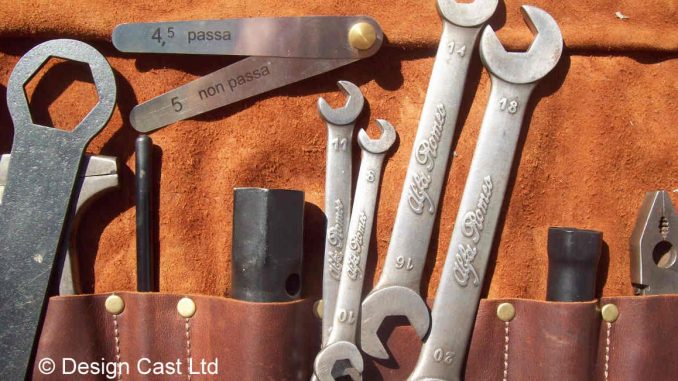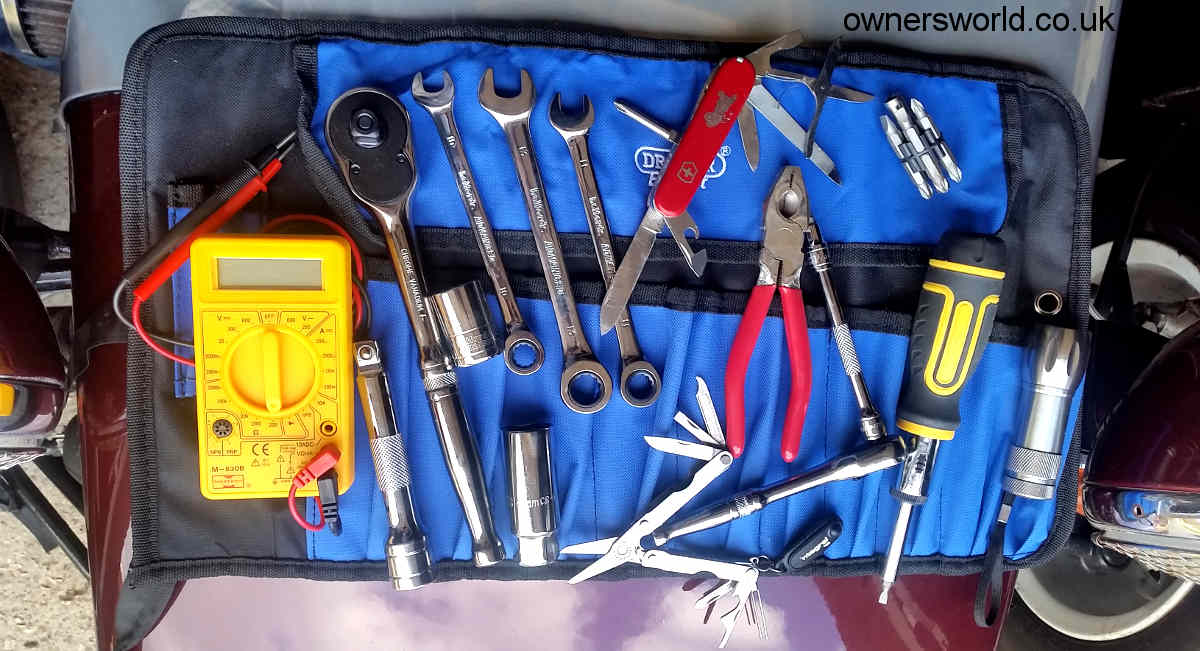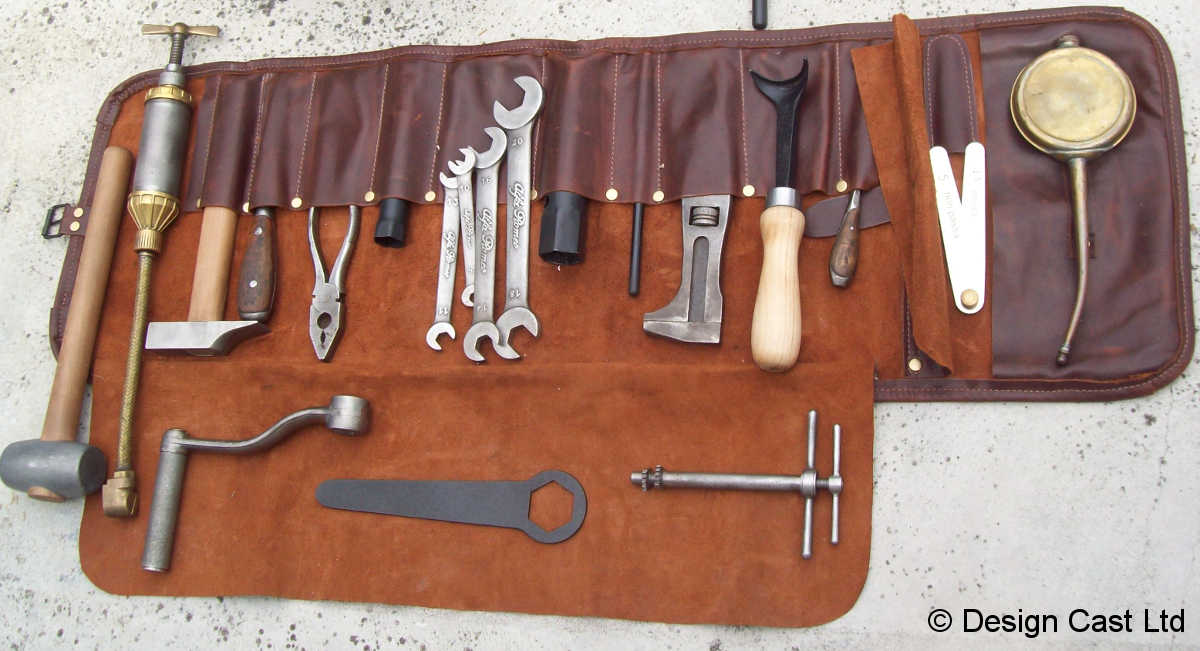
Whether you’re taking your classic on a gentle run out for a picnic at a car show; an epic off-road trail through the mountains or the annual pilgrimage to Le Mans, the right car tools, spares and roadside assistance in your classic car tool kit, can turn an emergency breakdown from being an adventure-stopping event into merely an irritation.
I recently published a post asking for your input into what preparation and which car tools and car spares you should carry with you in your classic car tool kit. I got a fantastic response and, having sifted all of the feedback, here is a list to help with your preparations.
Contents
You can use these links to navigate directly to an appropriate section of the article
- Preparation
- Essentials for any trip
- The Tool Kit
- Spares and Repair
- Top 10 Tool Kit Tips
- Example Tool Kit for EDC
- Concours Tool Kit
Which tools should you take?
It depends on quite a number of factors and everyone will have different (and, I have discovered, very strongly held) opinions on what you should take.
Key factors that affect how comprehensive your classic car tool kit and car spares list are:
- Your knowledge and mechanical capability
- Your willingness to carry out roadside repairs
- The length and duration of the journey
- Distance from and availability of help, parts, food/water and safety
- Whether you are travelling alone or as part of a group
- Your personal attitude to risk
One suggestion was “I rely on regular servicing and maintenance … and crossed fingers!” whereas another, very comprehensive suggestion, elicited a response of “You could almost build a car from those parts.”
Ultimately, it is up to you to decide which tools to take or leave behind. Treat this article as an aide memoire for preparing your classic car tool kit for your next adventure.
Preparation
There is a saying that “Proper Preparation Prevents Poor Performance” (there is a 6P’s version of this saying, but this is a family show!)
If you use your car regularly then you probably already know whether it is fit for the journey. Still, it doesn’t harm to give it the once over. Tyres, fuel, oil, water, fluid levels, hoses and belts not perished.
If you only use your car very infrequently, be more thorough. Maybe it’s time to change the fuel filter and give the car a good service.
If you are not mechanically minded, you need a good mechanic that you can trust to look after your car. Ask them to carry out this pre-journey check for you.
Essentials for any trip
If you do nothing else for your journey, take these items with you.
- Insurance cover – policy number and telephone number
- Breakdown / Roadside Assistance Insurance – policy number and telephone number
- Money, Credit card
- Mobile phone and in-car charger (but remember that phones break and can be out of signal coverage)
- Spare wheel (and locking wheel nut key)
There is no point spending money on breakdown insurance if you don’t have the correct telephone number to call when you need it. And when the repair man arrives, he can only change your wheel if you have brought it with you!
The Classic Car Tool Kit
Many people who responded, made the point that you need different car tools for different cars, which is true. There are definitely common themes though. Spanners; you may need 7/16″ AF for 1950’s British BMC car; or an 11mm for a 1970’s BMW but, if I say “appropriate spanners” I hope you’ll understand that I can’t list every spanner required for every car.
Torch – It’s difficult to fix anything in the dark, so take a good torch, ideally 2. I like to take a head torch so that I can keep both hands free for working. A second, magnetic (or clamp) torch is useful to keep a light on the work area. Make sure you check the batteries before you set off.
Spanners / Wrenches – You will need an appropriate set of spanners for your specific car. If it’s a British car from the 50’s, 60’s or 70’s, the following are common sizes 7/16″, 1/2″, 9/16″ and 5/8″ AF. A European car will more likely use 10mm, 11mm and 13mm.
2 x 6″ adjustable spanners may not be the holy grail of engineering, but they will get you out of the odd sticky situation.
One suggestion was “a large adjustable wrench (doubles as a hammer)” 🙂
Screwdrivers – You will probably want to carry a variety of screwdrivers; cross-head and flat-head, long and short. I have a multi-bit screwdriver with a variety of bit sizes as well as hex bits. The bits can be used in a 1/4″ socket to get into tight places.
Sockets – It depends on how much space you have as to whether you take a complete socket set in its case or whether you just take a small selection that you know are appropriate for your car. At a minimum, I would suggest a spark plug socket, extension bar and t-bar (or a dedicated spark plug spanner). If you have a set of hex-bits for your multi-bit screwdriver, then a 1/4″ socket with ratchet drive and extension bar is quite a useful addition for getting into tight spaces.
A couple of people mentioned taking a torque wrench. For me, any job that requires a torque wrench is probably not a job that I will carry out at the roadside. Like all of the suggestions, it is up to you to decide what to take.
Pliers – long nose and combination pliers. Ensure that the cutting edges are still in good enough condition to cut and strip electrical wire. A set of vice grips is a great addition to the kit.
Electrical – Wire cutters / wire strippers. Multimeter / Continuity tester / test light (see article Best Multimeters.) Long wire with alligator clips can help to isolate an electrical problem.
A wiring diagram and fuse and relay layout drawings (laminated) will really help with fault finding.
Jump leads or car battery booster pack (can also be used for charging a mobile phone).
Tyres – A tyre Inflator (either a compressor which plugs into the cigarette lighter or footpump); Car Jack (see article Best Car Trolley Jack); Wheel brace / wrench / Knock-off hammer (and spare wheel of course).
Multi-tools – Although a multi-tool won’t replace all of the tools mentioned above, they are great all-rounders to carry if you are only carrying the essentials. They typically comprise a knife, scissors, pliers, screwdrivers (flat and cross-head), a saw (and a thing for getting stones out of horses hooves!).
If you do decide to buy one, spend a bit of money and get a good quality one such as Leatherman, Gerber or Swiss Army knife. The cheap ones tend to break very quickly.
Miscellaneous – The following didn’t really fit into any other category so good old miscellaneous to the rescue.
Allen keys, feeler gauge, hammer, scissors, sharp knife, junior hacksaw, fuel can, water bottle for radiator top-ups, tow rope and penny washer for Dzus fasteners, shovel.
A clear pipe for bleeding brakes and clutches.
Reference – If you intend doing any work other than changing a spare wheel, it can be useful to carry some reference material. An owners workshop manual. A settings card with, for example, the following information: tyre pressures, plugs and points gap, static timing setting. As mentioned above, a wiring diagram and fuse and relay layout drawings (laminated) will really help with fault finding.
Health, Safety and Clean up – You don’t want to turn up at Goodwood Revival in your plus-fours and tweed jacket all covered in grease. A pair of overalls or a tarpaulin to lie on. A pair of Latex/PVC or Nitrile gloves to keep your hands clean and a roll of kitchen towel to clean/mop up. Some people like the packs of hand wipes but I find that they dry out once you’ve opened them and don’t use them for a while.
Take a good first aid kit, a fluorescent and reflective jacket and clothing to protect you from the weather (extreme heat, cold, wind and rain). One of those silver thermal blankets per passenger is a good idea as they are cheap, small and very effective.
A few snacks and a bottle of water can prevent the onset of becoming “Hangry”.
Toolbag – Whichever tools and spares you take in your classic car tool kit, make sure they are not randomly floating around the car. It makes it difficult to check that you have everything and you are almost guaranteed not to find the required tool when you most need it.
Get a good tool roll, tool bag or even a Tupperware box to store your kit in, so that you can find it easily when you need to.

Car Spares and Repair
Similarly to the car tool kit list, there are many different car spares that you could take for many different types of cars. One of the recommendations was to take a spare distributor with cap, leads and condenser and points already installed and set to the correct gap. This is a great idea for any car but I will not be able to list all of the distributors for all of the cars!
Fluids – As well as checking all of the fluid levels before you set off, you may want to carry some or all of these: Engine Oil, Brake fluid, Clutch fluid, Power steering fluid, Anti-Freeze, Fuel and Water.
Tyres – Always check that your spare wheel is serviceable and the tyre is inflated correctly. It would be quite embarrassing get the spare out at the side of the road only to find that you hadn’t had it fixed since the last time you had a puncture.
As a belt-n-braces approach, take a tyre inflation kit (gloopy foam that seals the puncture and inflates the tyre) – I have not been able to get a definitive answer as to whether these kits are safe for tyres with inner tubes.
Puncture repair kit. Depending on your wheels, you may need an inner tube repair kit or a tyre repair kit with plugs (I have never used one of these but will definitely investigate as quite a few people have recommended them.)
Electrical – Fuses (Lots for British Cars 😊 ) / fuse wire; Relays (Ignition, Fuel, Lights …); Bulbs; Sensors; A coil of insulated electrical wire.
Ignition – For the distributor; cap, points, condenser and rotor arm. A spare coil and ballast resistor. A single spark plug and spark plug lead.
Cables – Throttle, clutch and handbrake cable. Depending on the age of your car, a brake cable.
Hoses – Hoses and hose clamps – heater, fuel, water and oil.
Miscellaneous – Fan/Alternator belt, fuel pump, fuel filter, water pump, thermostat, gaskets/gasket jointing compound (hylomar, hermetite or similar), exhaust bobbin/hanger.
Repair – WD40 (did you know that it stands for Water Displacement formula number 40), Duct/Duck/Gaffer tape, Metallic Tape (doesn’t melt in hot applications), Hose repair kit, A few nuts, bolts and washers.
Top 10 Tool Kit Tips
Although these tips were put forward by people in respect of specific cars, they may help you to solve a problem on your own classic.
- Ensure all spares are tested and working before setting off (including batteries for torches, multimeters etc).
- If you’re touring in a group, you can coordinate the tools and spares list to cover most eventualities. You’re unlikely to need 15 socket sets.
- Instead of individual spares for your distributor, take a distributor with a condenser, rotor arm and fresh points already gapped and capped, with HT leads attached. Ready to swap in if needed.
- Likewise, a tried and tested fuel pump, with some stubs of hose and clamps attached will save time, scraped knuckles and bad language!
- Some people have fitted a spare coil / spare fuel pump alongside the existing items. These are then ready to swap over connections should the need arise.
- Already mentioned a couple of times, but I like this one. A wiring diagram and fuse and relay layout drawings (laminated) will really help with fault finding.
- If you are short on space, a scissor jack, handle and spare alternator belt can be cable tied to chassis members under the nosecone.
- Be creative about where you store your car tools and spares. They can be fitted under the spare tyre; boot/trunk; footwell; engine bay. But make sure that they are secure and won’t fall out on your journey.
- If you have a number of cars, put together individual kits for each car (4 cars = 4 kits).
- Experience – Take a folding chair, a good book and something to drink whilst you wait for the roadside assistance to arrive 🙂
Example Classic Car Tool Kit for EDC
If you’re a bit of a nerdy gadget and tool freak, look on Pinterest or Google for “EveryDay Carry” or EDC and be prepared to waste a lot of time.
The idea is basically to put together the minimum set of tools, gadgets, bits and pieces that you carry around, so that like a good boy scout, you can “Be Prepared!”.
In that vein, here is my attempt at an EDC Car Tool Kit for your classic.
- Essentials – Roadside assistance / Insurance contact details; Money, Credit card; Mobile phone and in-car charger.
- Head-torch.
- Leatherman Wave Multi-tool – flat head, cross head screwdrivers; Pliers, Knife, Scissors …
- 2 x 6″ Adjustable spanners.
- Small multi-meter.
- Fuse(s), Relay(s) and Bulbs.
- A roll of electrical wire (for electrical repair and tying things back on!)
- small roll of Gaffer/Duck/Duct tape.
- Small can of WD40.
- A small, rip-stop bag to carry it in.
- spare wheel.
- Jack, locking wheel nut key, Wheel brace / wrench / Knock-off hammer.
For those of you that prefer to carry a comprehensive set of car spares and tools all the time, then I know that this car tool kit list will not suffice but hey, it’s just another point of view.
Concours Tool Kits
There are other reasons to put a classic car tool kit together. If you attend car shows, it’s always nice to see period accessories displayed with a car. Old driving maps, period magazines and the original car tools, all add to the spectacle of the show.
Colin Howard recently put together this superb, complete vintage car tool kit for a 1931-1934 Alfa 8c 2300

“…it’s interesting what was necessary in the days gone by. Lead hammer, steel hammer, grease gun, 2 x screwdrivers, 4 x open spanners, tommy bar, 2 x tube spanners (front and rear hubs and spark plug) combination pliers, valve adjusting tool, valve depressing tool, jack, jack handle, feeler blades, adjustable spanner, carb jet tool, oil can, hub puller … and a leather tool roll”
Summary
When you come to put your Classic Car Tool Kit together, you need to balance which jobs you are prepared to carry out at the roadside with the risk of getting stranded due to an emergency breakdown. You may need to consider the availability of spares and roadside assistance. Whether you are travelling through urban areas or remote off-road trails.
Whichever type of journey you are embarking on, use the information in this article to ensure that you are properly prepared with the correct car tools and spares … and then hope that you never need to use them!






Another great article, thanks for taking the time. I’m saving my pennies for a lithium jump starter. Heard great things about them, powerful enough to start a car with a flat battery, has usb outlets for phones, Go pros etc(Spoke to someone yesterday with a Vintage Bentley who uses one to power all his bits without having to discreetly plumb in modern electrics). It’s also so small it can fit in the glove box of my MGF.
On the subject of MGF and ref the Concours tool kit. The Alfa kit looks brilliant and the tools are suitable for the job. There was an option for the MG for a road side kit which looked great but the tools are made of chocolate.. these go on auction sites, and are subject to scene tax, for around £100 now. They are about as useful as a K series head gasket! Changing times I guess.
Thanks Phil. I’ll be really interested to see the jump starter when you get it. As for the MGF toolkit, maybe there’s an opportunity to replicate the kit with good quality tools and make them available on ebay et al 🙂